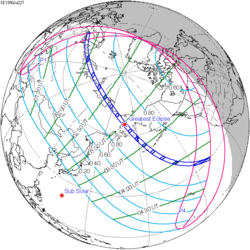| Total eclipse | |
 Totality photographed in Wadesboro, North Carolina, by Thomas Smillie for the Smithsonian Solar Eclipse Expedition to capture photographic proof of the solar corona | |
| Gamma | 0.3943 |
|---|---|
| Magnitude | 1.0249 |
| Maximum eclipse | |
| Duration | 130 s (2 min 10 s) |
| Coordinates | 44°48′N46°30′W / 44.8°N 46.5°W |
| Max. width of band | 92 km (57 mi) |
| Times (UTC) | |
| Greatest eclipse | 14:53:56 |
| References | |
| Saros | 126 (41 of 72) |
| Catalog # (SE5000) | 9281 |
A total solar eclipse occurred at the Moon's descending node of orbit on Monday, May 28, 1900, [1] [2] with a magnitude of 1.0249. A solar eclipse occurs when the Moon passes between Earth and the Sun, thereby totally or partly obscuring the image of the Sun for a viewer on Earth. A total solar eclipse occurs when the Moon's apparent diameter is larger than the Sun's, blocking all direct sunlight, turning day into darkness. Totality occurs in a narrow path across Earth's surface, with the partial solar eclipse visible over a surrounding region thousands of kilometres wide. Occurring about 3.9 days after perigee (on May 24, 1900, at 17:30 UTC), the Moon's apparent diameter was larger. [3]
Contents
- Viewing
- Eclipse details
- Eclipse season
- Related eclipses
- Eclipses in 1900
- Metonic
- Tzolkinex
- Half-Saros
- Tritos
- Solar Saros 126
- Inex
- Triad
- Solar eclipses of 1898–1902
- Saros 126
- Metonic series
- Tritos series
- Inex series
- Notes
- References
The path of totality was visible from parts of Mexico, the states of Texas, Louisiana, Mississippi, Alabama, Georgia, South Carolina, North Carolina, and Virginia in the United States, Portugal, Spain, Algeria, Tripoli, and Egypt. A partial solar eclipse was also visible for parts of North America, Central America, the Caribbean, northern South America, Europe, West Africa, and North Africa.










































































































